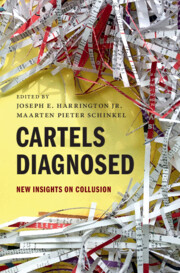Book contents
- Cartels Diagnosed
- Cartels Diagnosed
- Copyright page
- Contents
- Figures
- Tables
- Contributors
- Introduction
- 1 Entry Barriers, Personal Relationships, and Cartel Formation
- 2 “Now You Are Asking for a Real War!”
- 3 Coordinating Fuel Surcharges
- 4 Price Fixing or Fixing Competition?
- 5 The Role of Platforms for Facilitating Anticompetitive Communication
- 6 Collusion with Non-express Communication
- 7 Cartel Instability and Price Wars
- 8 Coordinated Rebate Reductions and Semi-collusion
- 9 Average Bid Auction Format Facilitates Bidding Rings
- 10 The Challenges of Cartelization with Many Products and Ongoing Technological Advancements
- 11 Two Cartels in the Supply Chain
- 12 Is it Collusion or Competition behind Price Parallelism?
- References
8 - Coordinated Rebate Reductions and Semi-collusion
Retail Gasoline in Sweden*
Published online by Cambridge University Press: 06 December 2024
- Cartels Diagnosed
- Cartels Diagnosed
- Copyright page
- Contents
- Figures
- Tables
- Contributors
- Introduction
- 1 Entry Barriers, Personal Relationships, and Cartel Formation
- 2 “Now You Are Asking for a Real War!”
- 3 Coordinating Fuel Surcharges
- 4 Price Fixing or Fixing Competition?
- 5 The Role of Platforms for Facilitating Anticompetitive Communication
- 6 Collusion with Non-express Communication
- 7 Cartel Instability and Price Wars
- 8 Coordinated Rebate Reductions and Semi-collusion
- 9 Average Bid Auction Format Facilitates Bidding Rings
- 10 The Challenges of Cartelization with Many Products and Ongoing Technological Advancements
- 11 Two Cartels in the Supply Chain
- 12 Is it Collusion or Competition behind Price Parallelism?
- References
Summary
◦ All collusion is, in effect, semi-collusion as coordinating on some dimensions intensifies competition on uncoordinated dimensions, of which some are always remaining, and that reduces the profitability of collusion. In this case of the Swedish market for gasoline and diesel, collusion occurred on pump prices which intensified competition on rebates and consequently induced firms to also collude on rebates.
◦ There are two crucial features of this market relevant to the cartel episode, First, while many consumers pay the pump price, large corporate customers, such as transport and taxi companies, received a negotiated rebate on the pump price. Second, at the time of the particular incident being examined, the normal mode of market conduct was for firms to collude on pump prices. The resulting supracompetitive price-cost margin on pump prices caused firms to compete aggressively for larger consumers through rebates.
◦ The cartel episode of interest pertained to firms coordinating to remove these rebates. In the legal case, the firms claimed the coordinated removal of rebates was exactly offset by a reduction in pump prices, so there was no net effect on their corporate customers’ prices and those customers who paid pump prices were better off.
◦ The case study’s analysis does not support this claim for there is found to be a return of the pump price margin to its initial level. Large customers who lost their rebates were worse off, while small customers experienced only a brief period of lower pump prices, before prices returned to their initial higher level.
- Type
- Chapter
- Information
- Cartels DiagnosedNew Insights on Collusion, pp. 222 - 248Publisher: Cambridge University PressPrint publication year: 2025

